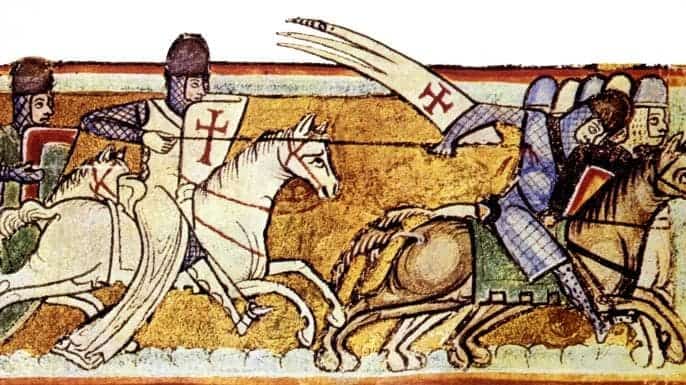Friday the 13th & Knights Templar
Why Friday the 13th Spelled Doom for the Knights Templar
Why are Fridays that fall on a month’s 13th day so fearful?
Some attribute the origins to the Code of Hammurabi, one of the world’s oldest legal documents, which may or may not have superstitiously omitted a 13th rule from its list. Others claim that the ancient Sumerians, who believed the number 12 to be a “perfect” number, considered the one that followed it decidedly non-perfect.
One of the most popular theories, however, links Friday the 13th with the fall of a fearsome group of legendary warriors—the Knights Templar. Founded around 1118 as a monastic military order devoted to the protection of pilgrims traveling to the Holy Land following the Christian capture of Jerusalem during the First Crusade, the Knights Templar quickly became one of the richest and most influential groups of the Middle Ages, thanks to lavish donations from the crowned heads of Europe, eager to curry favor with the fierce Knights. By the turn of the 14th century, the Templars had established a system of castles, churches and banks throughout Western Europe. And it was this astonishing wealth that would lead to their downfall.
For the Templars, that end began in the early morning hours of Friday, October 13, 1307.
A month earlier, secret documents had been sent by couriers throughout France. The papers included lurid details and whispers of black magic and scandalous sexual rituals. They were sent by King Philip IV of France, an avaricious monarch who in the preceding years had launched attacks on the Lombards (a powerful banking group) and France’s Jews (who he had expelled so he could confiscate their property for his depleted coffers).
In the days and weeks that followed that fateful Friday, more than 600 Templars were arrested, including Grand Master Jacques de Molay, and the Order’s treasurer. But while some of the highest-ranking members were caught up in Philip’s net, so too were hundreds of non-warriors; middle-aged men who managed the day-to-day banking and farming activities that kept the organization humming. The men were charged with a wide array of offenses including heresy, devil worship and spitting on the cross, homosexuality, fraud and financial corruption.
For the Templars, that end began in the early morning hours of Friday, October 13, 1307.
A month earlier, secret documents had been sent by couriers throughout France. The papers included lurid details and whispers of black magic and scandalous sexual rituals. They were sent by King Philip IV of France, an avaricious monarch who in the preceding years had launched attacks on the Lombards (a powerful banking group) and France’s Jews (who he had expelled so he could confiscate their property for his depleted coffers).
In the days and weeks that followed that fateful Friday, more than 600 Templars were arrested, including Grand Master Jacques de Molay, and the Order’s treasurer. But while some of the highest-ranking members were caught up in Philip’s net, so too were hundreds of non-warriors; middle-aged men who managed the day-to-day banking and farming activities that kept the organization humming. The men were charged with a wide array of offenses including heresy, devil worship and spitting on the cross, homosexuality, fraud and financial corruption.


